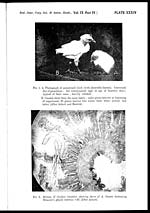Medicine - Veterinary > Veterinary colleges and laboratories > Indian journal of veterinary science and animal husbandry > Volume 9, 1939 > Original articles > Important helminth parasites of poultry - their treatment and control
(326) Page 400
Download files
Individual page:
Thumbnail gallery: Grid view | List view

400 Important Helminth Parasites of Poultry
the tenth to the nineteenth day they attack the intestinal wall. The majority
make their way into the crypts of Lieberkuhn, burying into the tissues, with
the rest of the body hanging in the lumen. A few of the larvæ, specially when
present in large number, may burrow more deeply into the wall or may com-
pletely penetrate it, and through the circulation eventually reach the liver and
lungs. Some are arrested in these organs while others return to the intestine
through the bronchi, trachea, pharynx and oesophagus. In normal cases,
the larvæ withdraw from the intestinal wall after the 19th day and are
found in the lumen where they grow into adults.
The pathogenic effects are very marked during the first three weeks.
The symptoms appear in the first week and become more pronounced during
the second and third weeks, and the loss in weight is also marked. From a
consideration of the life-history of the parasite, it is obvious that its pathogeni-
city during the first week is solely due to the presence of the larvæ in the
lumen of the gut and that the more marked effects during the second and
third weeks are associated with the period when the larvæ attack the intestinal
tissue—10th to 19th days. The attack of the larvæ produces varying degree
of superficial erosion of the mucous membrane and extensive destruction of the
epthelial lining of the crypts and haemorrhage. After the return of the larvae
into the lumen, there may be a short period of recovery when the birds may
gain in weight, but soon the larvae attain maturity and early in the fourth
week their adverse effects upon the body weight became apparent. Young
birds suffer much more than old ones (Plate XXXIV, fig 1). The first symp-
toms are loss of appetite, abnormal thirst, with a depressed, bumped-up, un-
thrifty and drowsy appearance, ruffled and dull feathers and drooping wings.
Destruction of the intestinal glands (Plate XXXIV, fig 2), hæmorrhages, severe
enteritis and diarrhœa may result from the invasion of the intestinal wall
by the larvæ. During the third week of infestation, growth is retarded and
loss in weight is marked and mortality high. Appetite of the birds that
survive may thereafter become voracious and recovery may be rapid, pro-
vided the infestation is not heavy, and the host may eventually throw off
most of the worms. In cases of heavy infestations, however, there is pro-
gressive anaemia and emaciation. The gradual loss of strength eventually
results in a conspicuous leg weakness. The affected birds walk with a
staggering gait and ultimatelybecome prostrated, till death intervenes, which
may be as early as the 10th day after infestation. There is also a
marked decline in egg production. As a result of heavy infestation the
thymus gland is greatly reduced and the blood may lose a significant part
of its sugar, thereby rendering the birds susceptible to various diseases.
The development of a resistance by the chicken to infestation with this
round-worm as well as to its ill-effects has received considerable attention in
recent years. It has been demonstrated that certain factors, such as, age,
pre-infestation, deficient diet, loss of blood and the breed of the host, govern
the acquisition of a resistance by the bird to ascaridiasis. One of the classical
examples of age resistance to an helminth parasite is provided by the develop-
ment with increasing age of a marked resistance in the chicken to infestation
Set display mode to: Large image | Zoom image | Transcription
Images and transcriptions on this page, including medium image downloads, may be used under the Creative Commons Attribution 4.0 International Licence unless otherwise stated. ![]()
| Permanent URL | https://digital.nls.uk/75247606 |
|---|
| Description | Covers articles from 1939. Please note that pagination starts at p.139 and plates at Plate V. |
|---|




